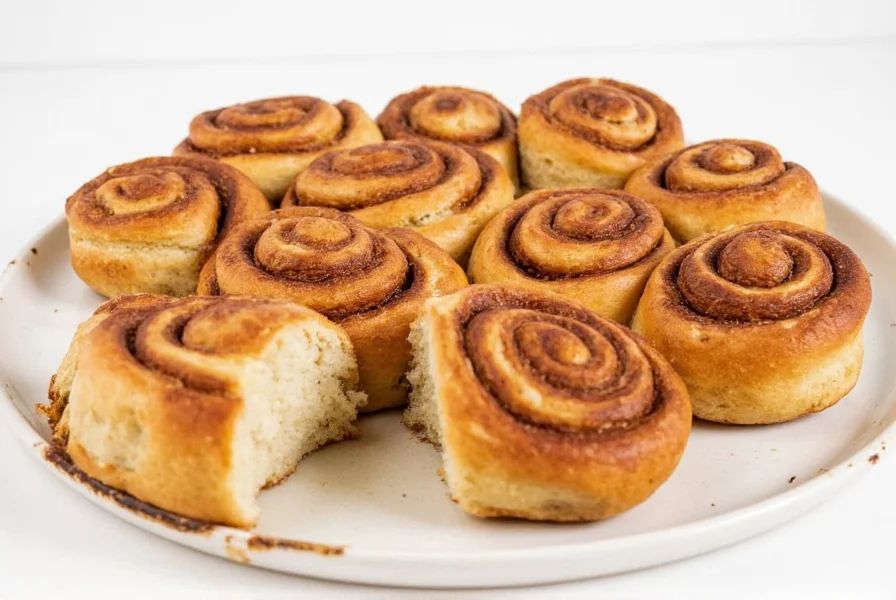The Unique Appeal of Sourdough Cinnamon Rolls
Sourdough cinnamon rolls represent the perfect marriage of artisan baking techniques and comforting classic flavors. While traditional cinnamon rolls rely on commercial yeast for quick rise, sourdough versions harness wild yeast and lactic acid bacteria for deeper flavor development. The natural fermentation process creates subtle tanginess that balances the sweetness, while improving dough structure and shelf life.
Professional bakers appreciate how sourdough's enzymatic activity breaks down complex starches, resulting in a more tender crumb and enhanced aroma. Home bakers discover that using sourdough discard transforms what would be waste into delicious treats, making this recipe both economical and sustainable.
Essential Ingredients for Perfect Sourdough Cinnamon Rolls
The magic happens through careful ingredient selection:
| Ingredient | Traditional Role | Sourdough-Specific Function |
|---|---|---|
| Active Sourdough Starter | N/A | Provides natural leavening and complex flavor development |
| Sourdough Discard | N/A | Creates tender texture without additional rise time |
| Bread Flour (12-13% protein) | Structure | Withstands longer fermentation without breaking down |
| Cultured Butter | Flavor/Texture | Complements sourdough's tanginess with nutty notes |
Mastering the Sourdough Cinnamon Roll Process
Creating exceptional sourdough cinnamon rolls requires understanding the fermentation timeline. Unlike quick-rise versions, sourdough benefits from extended, controlled fermentation that develops flavor without compromising texture.
Cold Fermentation Method (Recommended)
- Mix dough ingredients and perform 3-4 stretch-and-folds during first hour
- Refrigerate dough for 12-24 hours for optimal flavor development
- Remove from refrigerator 2 hours before rolling to temper
- Roll, fill, and cut while dough is cool but pliable
- Proof at room temperature for 3-5 hours until puffy
- Bake immediately when properly proofed
Troubleshooting Common Sourdough Cinnamon Roll Issues
Even experienced bakers encounter challenges with sourdough cinnamon rolls. Understanding these common problems ensures success:
- Flat rolls after baking: Over-proofing is the most common culprit. Sourdough requires careful monitoring as it continues fermenting while proofing. The dough should spring back slowly when gently pressed.
- Weak sourdough flavor: Extend the cold fermentation time up to 36 hours. Using 100% hydration starter creates more pronounced tang than discard-only versions.
- Filling leakage: Create a barrier by spreading a thin layer of cream cheese or egg wash before adding cinnamon-sugar mixture. Avoid overfilling the roll.
- Dense texture: Ensure your starter is active and vigorous. Discard-only recipes often benefit from adding 1/4 teaspoon instant yeast for reliable rise.
Advanced Techniques for Exceptional Results
Professional bakers use these methods to elevate their sourdough cinnamon rolls:
- Tangzhong method: Cooking a portion of the flour and liquid creates a water roux that dramatically improves moisture retention and shelf life.
- Double fermentation: Mix the dough, refrigerate overnight, then roll and fill before a second cold proof yields extraordinary flavor complexity.
- Spice infusion: Steeping cinnamon sticks in warm milk before incorporating develops deeper, more nuanced spice notes than ground cinnamon alone.
Storage and Reheating for Maximum Enjoyment
Sourdough's natural acidity extends freshness compared to conventional cinnamon rolls. For best results:
- Store at room temperature for up to 3 days in airtight container
- Freeze completely cooled rolls on baking sheet before transferring to freezer bags
- Reheat from frozen: 20-25 seconds in microwave followed by 5 minutes in 325°F oven
- Revive stale rolls with 10-second microwave burst and light steam application
Why Sourdough Cinnamon Rolls Outperform Traditional Versions
While traditional cinnamon rolls have their place, sourdough versions offer distinct advantages that satisfy both artisanal bakers and comfort food enthusiasts. The natural fermentation process breaks down phytic acid, potentially improving nutrient absorption. The lactic acid created during fermentation enhances flavor complexity while providing natural preservation.
Most importantly, sourdough cinnamon rolls deliver a more sophisticated flavor profile that balances sweetness with subtle tang, creating a treat that feels both nostalgic and innovative. The improved texture—tender yet structured—holds up better to storage and reheating, making them ideal for meal prep or special occasions.











 浙公网安备
33010002000092号
浙公网安备
33010002000092号 浙B2-20120091-4
浙B2-20120091-4